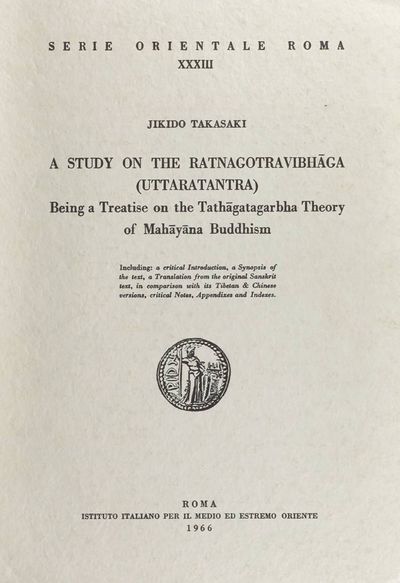A Study on the Ratnagotravibhāga (Uttaratantra)
No edit summary |
No edit summary |
||
| Line 56: | Line 56: | ||
*{{i|III. The Jewel of the Doctrine|163}} | *{{i|III. The Jewel of the Doctrine|163}} | ||
**{{i|1) The Eightfold Quality of the Doctrine|164}} | **{{i|1) The Eightfold Quality of the Doctrine|164}} | ||
**{{i|2) Nirodhasatya & | **{{i|2) ''Nirodhasatya'' & ''Mārgasatya''|165}} | ||
**{{i|3) The Doctrine as the Truth of Extinction|165}} | **{{i|3) The Doctrine as the Truth of Extinction|165}} | ||
**{{i|4) The Doctrine as the Truth of Path|168}} | **{{i|4) The Doctrine as the Truth of Path|168}} | ||
| Line 66: | Line 66: | ||
**{{i|2) Introspective Character of Bodhisattva’s Perception|176}} | **{{i|2) Introspective Character of Bodhisattva’s Perception|176}} | ||
**{{i|3) Superiority of Bodhisattva’s Community|176}} | **{{i|3) Superiority of Bodhisattva’s Community|176}} | ||
*{{i|V. The 3 Jewels as Refuges|180}} | |||
**{{i|1) 3 Refuges from the Empirical Standpoint|180}} | |||
**{{i|2) The Doctrine and the Community are not the ultimate refuge|181}} | |||
**{{i|3) Only the Buddha is the Refuge from the ultimate Standpoint|184}} | |||
**{{i|4) The Meaning of the 3 Jewels|185}} | |||
*{{i|VI. The Germ of the 3 Jewels in 4 Aspects|186}} | |||
**{{i|1) Inconceivability of the 4 Aspects|188}} | |||
**{{i|2) The Germ as Cause and Conditions of the 3 Jewels in its 4 Aspects|194}} | |||
*{{i|VII. The Sermon: All Living Beings are possessed of the ''Tathāgatagarbha''|196}} | |||
*{{i|VIII. Analysis of the Germ from 10 Points of View|199}} | |||
**{{i|(I) ''Svabhāva'' & (II) ''Hetu''|200}} | |||
***{{i|1) The Nature of the Essence of the Tathāgata|200}} | |||
***{{i|2) Obstructions and Causes for Purification|201}} | |||
**{{i|(III) ''Phala'' & (IV) ''Karman''|207}} | |||
***{{i|1) The 4 Supreme Virtues as the Result of Purification|208}} | |||
***{{i|2) Concordance between the 4 Supreme Virtues and the 4 Causes for Purification|210}} | |||
***{{i|3) 4 Impediments to the Attainment of the Supreme Virtues|214}} | |||
***{{i|4) Motives of the 4 Supreme Virtues|218}} | |||
***{{i|4') The Unstable Nirvāṇa|219}} | |||
***{{i|5) Functions of the Germ for its Purification|221}} | |||
(V) Yoga 225 | |||
1) The Union of the Germ to the Factors of its Purification .... 225 | |||
2) The Union of the Germ to the Result of Purification 227 | |||
(VI) Vrtti (Manifestation) 229 | |||
(VII) Avasthäprabheda (Different States of Manifestation) 230 | |||
(VIII) Sarvatraga (All-pervadingness) 233 | |||
Revision as of 16:24, 11 August 2020
Jikido Takasaki's seminal work on the Ratnagotravibhāga includes a critical introduction, a synopsis of the text, a translation from the original Sanskrit text in comparison with its Tibetan and Chinese versions, critical notes, appendixes, and indexes. The work is split into two parts. The first consists of a critical and detailed study on the structure of the text and the position of the Ratnagotravibhāga in Mahāyāna Buddhism, and the second consists of a translation of the Sanskrit text into English.
| Citation | Takasaki, Jikidō. A Study on the Ratnagotravibhāga (Uttaratantra): Being a Treatise on the Tathāgatagarbha Theory of Mahāyāna Buddhism. Serie Orientale Roma XXXIII. Rome: Istituto Italiano per il Medio ed Estremo Oriente (IsMEO), 1966. https://archive.org/details/bdrc-W1KG1582/page/n1/mode/2up. |
|---|---|


